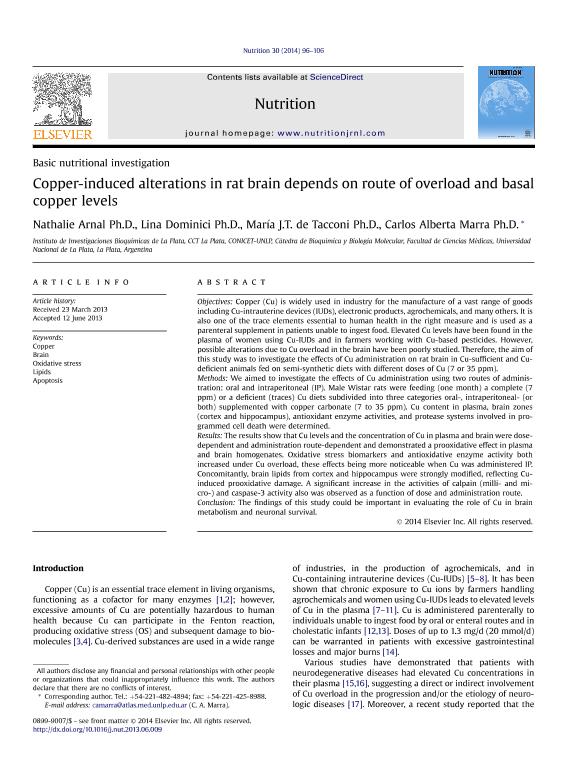Artículo
Copper-induced alterations in rat brain depends on route of overload and basal copper levels
Fecha de publicación:
01/2014
Editorial:
Elsevier Science Inc
Revista:
Nutrition
ISSN:
0899-9007
Idioma:
Inglés
Tipo de recurso:
Artículo publicado
Clasificación temática:
Resumen
Objectives Copper (Cu) is widely used in industry for the manufacture of a vast range of goods including Cu-intrauterine devices (IUDs), electronic products, agrochemicals, and many others. It is also one of the trace elements essential to human health in the right measure and is used as a parenteral supplement in patients unable to ingest food. Elevated Cu levels have been found in the plasma of women using Cu-IUDs and in farmers working with Cu-based pesticides. However, possible alterations due to Cu overload in the brain have been poorly studied. Therefore, the aim of this study was to investigate the effects of Cu administration on rat brain in Cu-sufficient and Cu-deficient animals fed on semi-synthetic diets with different doses of Cu (7 or 35 ppm). Methods We aimed to investigate the effects of Cu administration using two routes of administration: oral and intraperitoneal (IP). Male Wistar rats were feeding (one month) a complete (7 ppm) or a deficient (traces) Cu diets subdivided into three categories oral-, intraperitoneal- (or both) supplemented with copper carbonate (7 to 35 ppm). Cu content in plasma, brain zones (cortex and hippocampus), antioxidant enzyme activities, and protease systems involved in programmed cell death were determined. Results The results show that Cu levels and the concentration of Cu in plasma and brain were dose-dependent and administration route-dependent and demonstrated a prooxidative effect in plasma and brain homogenates. Oxidative stress biomarkers and antioxidative enzyme activity both increased under Cu overload, these effects being more noticeable when Cu was administered IP. Concomitantly, brain lipids from cortex and hippocampus were strongly modified, reflecting Cu-induced prooxidative damage. A significant increase in the activities of calpain (milli- and micro-) and caspase-3 activity also was observed as a function of dose and administration route. Conclusion The findings of this study could be important in evaluating the role of Cu in brain metabolism and neuronal survival.
Palabras clave:
Copper
,
Brain
,
Oxidative Stress
,
Lipids
Archivos asociados
Licencia
Identificadores
Colecciones
Articulos(INIBIOLP)
Articulos de INST.DE INVEST.BIOQUIMICAS DE LA PLATA
Articulos de INST.DE INVEST.BIOQUIMICAS DE LA PLATA
Citación
Marra, Carlos Alberto; Tacconi, Maria Josefa; Dominici, Lina Edith; Arnal, Nathalie; Copper-induced alterations in rat brain depends on route of overload and basal copper levels; Elsevier Science Inc; Nutrition; 30; 1; 1-2014; 96-106
Compartir
Altmétricas




